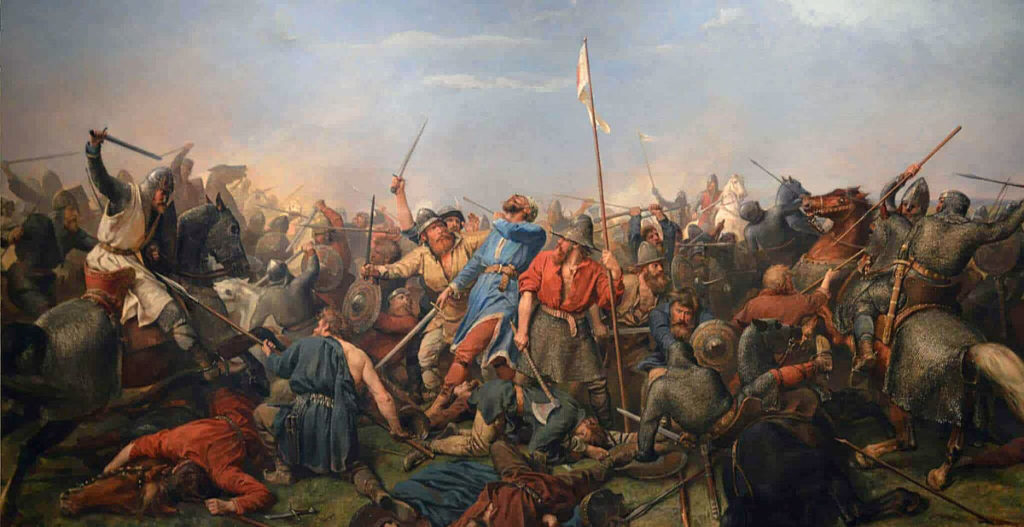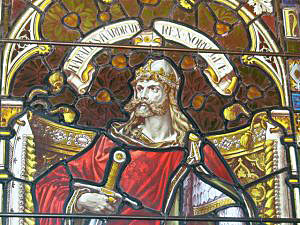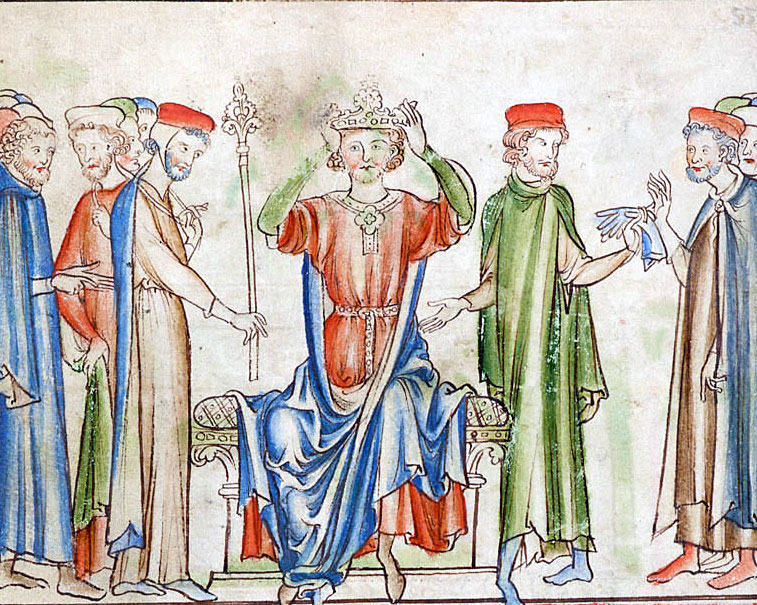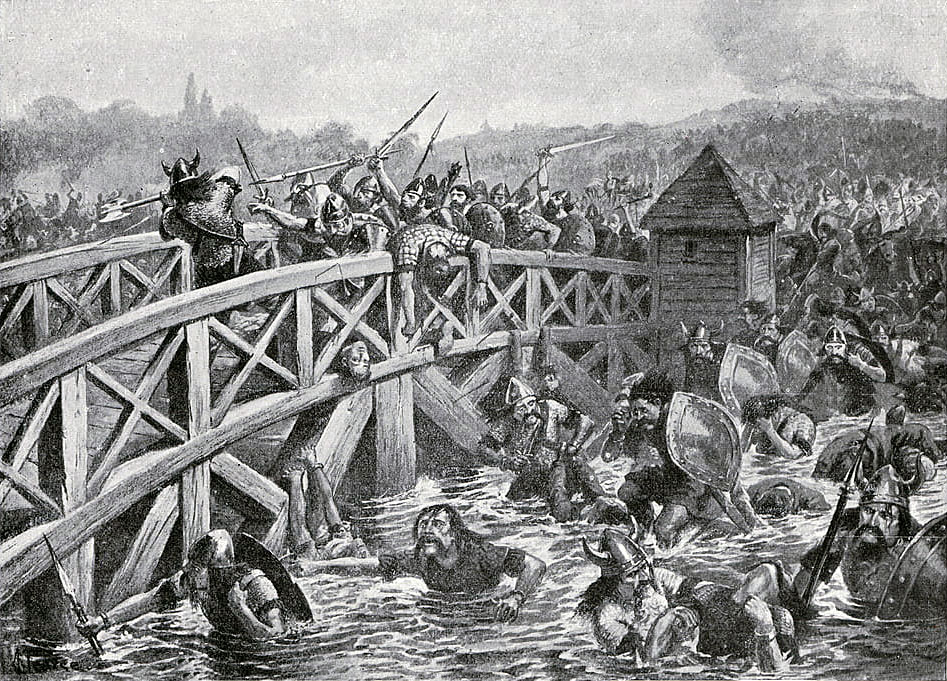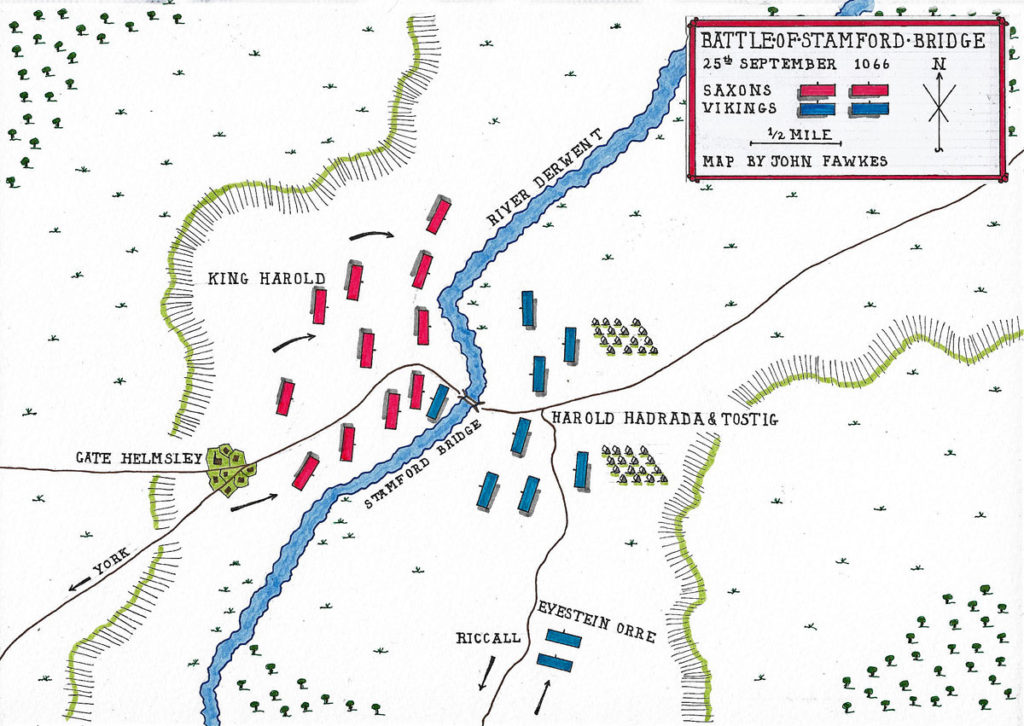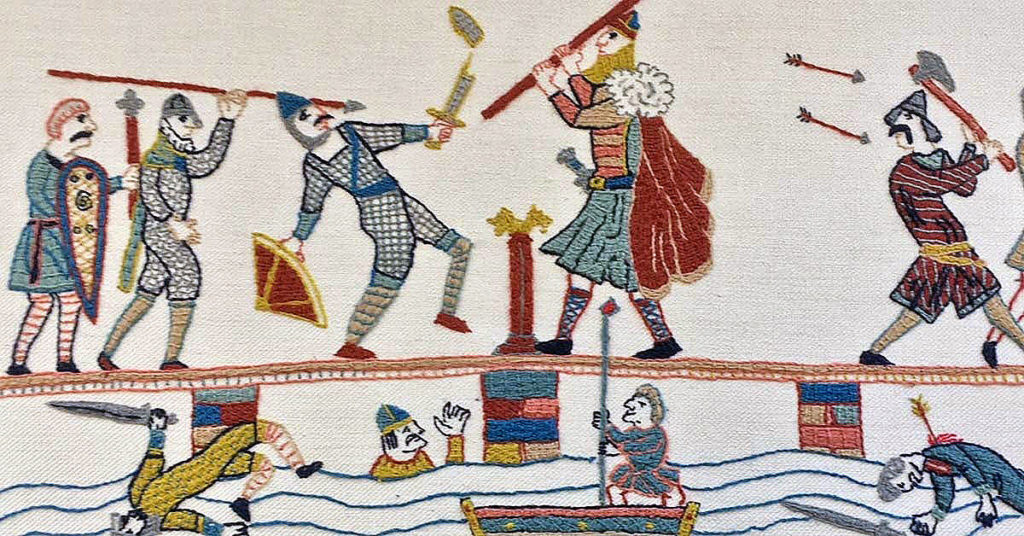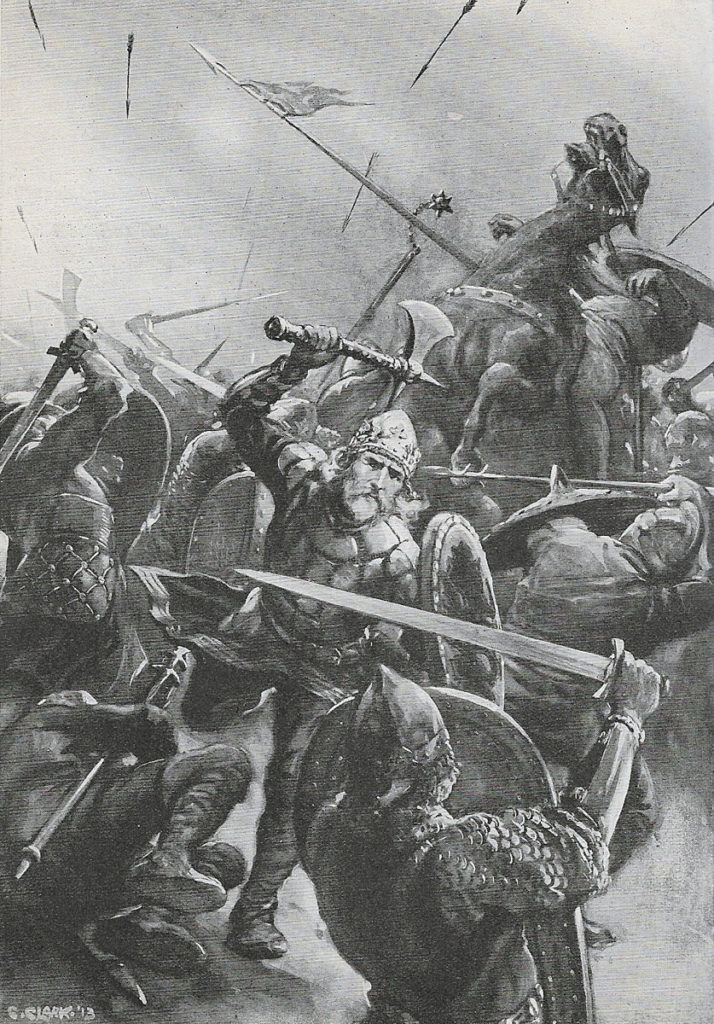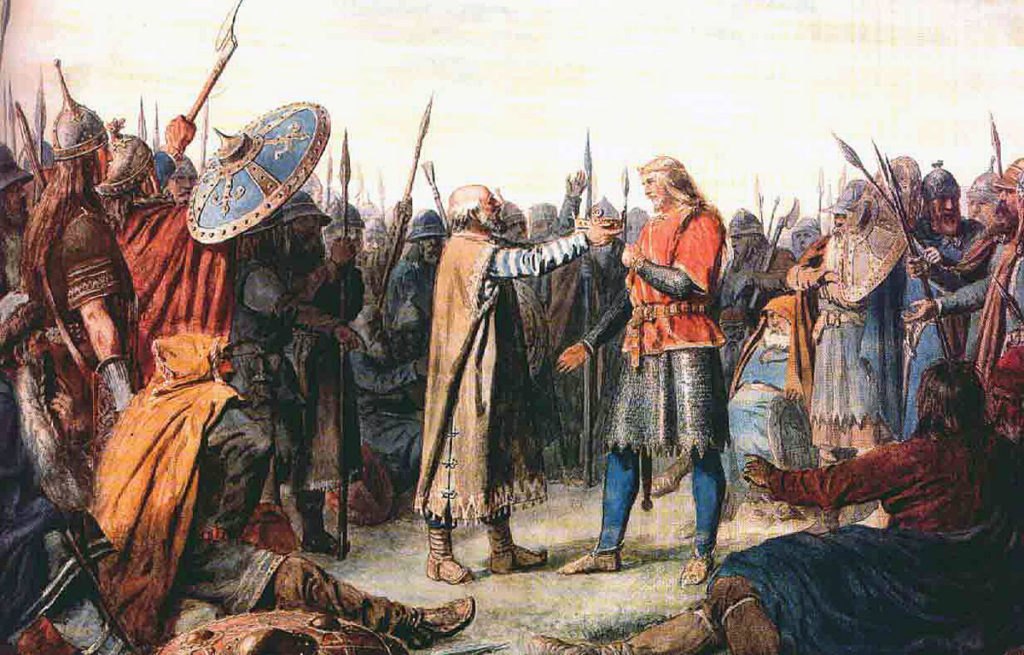The Battle in the North of England on 25th September 1066 where King Harold crushed the attempt of Harold Hardrada, King of Norway, to take the throne of England with the aid of Harold’s brother Tostig and a Viking army
The previous battle in the British Battles series is the Battle of Ashdown
The next battle in the Norman Conquest is the Battle of Hastings
War: Norman Conquest
Date of the Battle of Stamford Bridge: 25th September 1066
Place of the Battle of Stamford Bridge: 8 miles to the east of York in Northern England
Combatants at the Battle of Stamford Bridge: An Anglo-Saxon army against an army of Vikings, Scots, Flemings and English.
Commanders at the Battle of Stamford Bridge: Harold, King of England commanded the Anglo-Saxon army against Harold Hardrada, King of Norway and Earl Tostig, King Harold’s renegade brother.
Size of the armies at the Battle of Stamford Bridge: The kernel of King Harold’s army was his body of house-carls, numbering around 2,000 men. The main part of his army comprised the ‘fyrd’ levied in each district of the kingdom.
King Harold gathered the fyrd as he marched north to meet the Viking incursion, until they numbered around 8,000 men.
Harold Hardrada arrived in the north of England with a fleet of 200 Viking longships.
This fleet probably brought around 8,000 fighting men.
After leaving a guard for the ships at Riccall, Harold Hardrada marched with an army that probably numbered around 6,000 men.
Uniforms, arms and equipment at the Battle of Stamford Bridge:
Both armies were infantry forces, fighting on foot.
Such armour as was worn comprised shirts or long tunics of chain mail.
Those soldiers that could afford them wore pot helmets, some with a nose piece.
Long shields were carried.
Weapons were spears, swords and axes with sharpened agricultural tools for the peasant soldiers.
Some soldiers were armed with short bows, but they were not of decisive significance on the battlefield as the English archers were to become with the devastating longbow of the 100 Years War.
Winner of the Battle of Stamford Bridge: King Harold won the battle, Harold Hardrada and Tostig being killed with much of the Viking army.
Events leading to the Battle of Stamford Bridge:
Edward the Confessor, King of England, died on 5th January 1066.
The Witan, the Great Council of England, elected Harold Godwinsson, Earl of Wessex, his successor as king.
These were times of peril for England. Two other powerful rulers considered themselves the rightful King of England: William, Duke of Normandy, who prepared an invasion across the English Channel and Harold Hardrada, King of Norway.
The first rebellion against the new King Harold was launched by his brother Tostig.
The rebellion failed and Tostig took refuge in Scotland, from where he encouraged Harold Hardrada to invade England.
King Harold was in London in September 1066 when he heard that the Viking army of Harold Hardrada had crossed the North Sea and entered the Humber estuary, sailing up the River Ouse and landing at Riccall, south of the City of York.
At some point the Vikings were joined by Tostig.
Leaving a body of his 8,000 strong Viking army at Riccall to guard the long ships, Harold Hardrada advanced on York, 10 miles to the north, across a marshy landscape.
Harold Hardrada’s invasion was opposed by the Earls of Northumbria and Mercia, Edwin and Morcar and an army raised from their earldoms.
Edwin and Morcar advanced out of York to meet the approaching Vikings.
The opposing armies met at Fulford on 20th September 1066.
After a hard-fought battle Harold Hardrada drove the earls’ army off the field with great slaughter, many of the Anglo-Saxons being drowned in a ditch that ran alongside the road to York.
Instead of marching on York which was now largely defenceless, Harold Hardrada’s army fell back to Riccall.
Negotiations took place with the City of York for its surrender.
The terms of the agreement reached required the city to deliver hostages to Harold Hardrada.
Under the agreement these hostages were to be handed over at Stamford Bridge, a point between the city and Riccall, where a number of roads met at a bridge over the River Derwent.
Harold Hardrada’s Viking army marched to Stamford Bridge, where he encamped, leaving the army’s long ships at Riccall.
Account of the Battle of Stamford Bridge:
On 25th September 1066, soon after his arrival at the rendezvous, Harold Hardrada was surprised by the appearance on the far bank of the River Derwent of King Harold with his house carls and the English troops he had assembled during his four-day march from London to Stamford Bridge.
In the course of his rapid journey north, King Harold had sent messengers in advance, warning the local magnates of his arrival and the need for a substantial force of troops to meet Harold Hardrada’s Vikings.
Harold Hardrada’s army, in camp on the eastern bank of the River Derwent, was taken by surprise, unprepared for battle, many without their armour or weapons.
There were outposts from the Viking army on the west bank of the river and they hurried to stop King Harold’s men from crossing the bridge, while Harold Hardrada sent messengers to his subordinate, Eyestein Orre to bring up the reserve guarding the ships at Riccall, as quickly as possible.
The Saxons swept aside the Viking outposts on the west bank of the River Derwent, before advancing on the bridge, which they needed to cross to attack the main Viking army, hurriedly assembling on the far bank.
King Harold’s passage across the bridge was held up for some time by a single Viking ‘berserker’ who struck down every Saxon trying to pass him.
The ‘berserker’ was finally neutralised by a Saxon manoeuvring a swill-tub under the bridge and spearing the Viking through a gap in the walkway, allowing the Saxon army to pour across the bridge and attack Harold Hardrada’s unprepared army.
The Vikings formed a shield wall, which after some hours of hard fighting the Saxons penetrated.
Harold Hardrada was killed by an arrow or slingshot, leaving Tostig to take command.
Eventually Eyestein Orre arrived with the rear-guard, but it was too late. The Viking army, now leaderless, was beaten and slaughtered by the victorious Saxons.
Eyestein Orre and Tostig died as their soldiers were overcome.
Casualties at the Battle of Stamford Bridge:
Most of the army of Harold Hardrada and Tostig became casualties.
King Harold’s losses were heavy, particularly among his housecarls, leaving him to recruit a further army to confront Duke William of Normandy at the Battle of Hastings.
Follow-up to the Battle of Stamford Bridge:
Following the Battle of Stamford Bridge, King Harold was compelled to march south to meet the invasion of Duke William of Normandy with his army of Normans, Bretons and Frenchmen landing on the southern coast in Sussex.
The diversion of King Harold with his army to the north of England and his losses at Stamford Bridge at the very time when Duke William was crossing the Channel and landing on the Sussex coast was a major element in Harold’s defeat at the Battle of Hastings and the success of the Norman invasion.
References for the Battle of Stamford Bridge:
Battles in Britain 1066 to 1547 by William Seymour
A History of the Art of War in the Middle Ages Volume One: 378-1278 by Sir Charles Oman.
British Battles by Grant.
The previous battle in the British Battles series is the Battle of Ashdown
The next battle in the Norman Conquestis the Battle of Hastings
